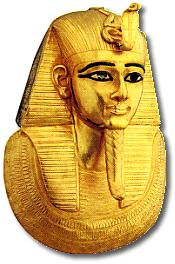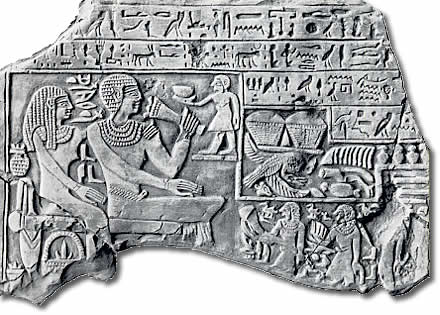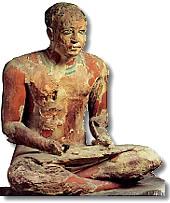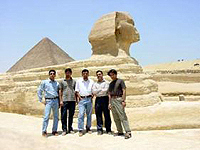< < < Back to Egypt Page

Source: Ancient-Egypt.org

| < < < Back to Main Page
< < < Back to Egypt Page |

Source: Ancient-Egypt.org |
 |
|---|
An introduction into the history of Ancient Egypt

|
|---|
From the end of prehistory at around 3.000 BC to the closing of the last Egyptian temple in 535/537 AD.

|
 Picture: Alexander the Great freed Egypt of the Persian yoke and added it to his own empire.
Picture: Alexander the Great freed Egypt of the Persian yoke and added it to his own empire.
When it was conquered by the Macedonean Alexander the Great, Egypt become part of the Hellenistic world. Alexander’s successors, the Ptolemies, ruled Egypt as an independent country and again made it one of the most prestigious countries in the world. Great building projects would promote these foreign kings as benefactors, pleasing both the gods and the people of Egypt.
The coming of Christianity started the final decline of this ancient culture.
 Picture: The high quality craftsman-ship of the 21st and 22nd Dynasties, as shown in this death mask of Psusennes I, does not justify this period being dubbed an "inter-mediate" period.
Picture: The high quality craftsman-ship of the 21st and 22nd Dynasties, as shown in this death mask of Psusennes I, does not justify this period being dubbed an "inter-mediate" period.
Dynastic fuels and the increased power of the Theban priests at the end of the 20th Dynasty left Egypt unable to deal with the changing political situation in the Near-East. The prestige it had held during the New Kingdom was lost along with its possessions in Syria-Palestine and Nubia.
Weakended and internally divided, Egypt lay open to attacks from Nubians, Assyrians and Persians who would impose their rule with varying success.
 Picture: Thutmosis III was the greatest conqueror of the New Kingdom.
Picture: Thutmosis III was the greatest conqueror of the New Kingdom.
With the expulsion of the Hyksos by the Thebans, Egypt started an imperial adventure that would make it the most powerful nation of its time.
Through a series of conquests the Egyptians gained control over Syria-Palestine and Nubia. Bounties and diplomatic gifts provided Egypt with a wealth that found its way to building projects of an unprecedented scale, honouring both the gods and the kings who had given Egypt its greatness.
Towards the end of the Middle Kingdom, the later kings of the 13th Dynasty gradually lost control over the central government, allowing local rulers to once again seize power over part of the country. Among them was a group of people of Asian origin, known as Hyksos, who would impose their reign on almost the entire country.
When the local Theban princes stopped recognising the Hyksos as Egypt’s legitimate rulers, the strength for freedom would begin.
 Picture: A lovely relief at Dendara shows Mentuhotep II in adoration.
Picture: A lovely relief at Dendara shows Mentuhotep II in adoration.
The reunification of Egypt by the Theban ruler Mentuhotep II ended the century of civil war that had followed the Old Kingdom. It also promoted Thebes from a simple provincial city to one of the country’s most important religious and political centers.
This was a time of restoration, when arts, crafts and Egypt’s political power would flourish again to a new high. Later generations would consider this as Egypt’s classical age.
 Picture: With the decline of the royal ateliers at Memphis, the art that was produced during the 1st Intermediate Period was crude, as shown by this funerary relief from Dendara.
Picture: With the decline of the royal ateliers at Memphis, the art that was produced during the 1st Intermediate Period was crude, as shown by this funerary relief from Dendara.
Egypt’s first golden era came to an end when, towards the end of the 6th Dynasty, the central government started losing control over the local administrations in the provinces. Several factors, including climatic changes had allowed local governors to strengthen their positions and rule their provinces as if they were kings themselves.
Out of this chaos arose two rivalling houses that would plunge Egypt into a civil war with control over the entire country as the ultimate prize.
 Picture: The scribe became the backbone of the powerful royal administration that would help the central government tighten its grasp on the Ancient Egyptian society, enabling impressive building projects at Dashur and Giza.
Picture: The scribe became the backbone of the powerful royal administration that would help the central government tighten its grasp on the Ancient Egyptian society, enabling impressive building projects at Dashur and Giza.
With the central government’s power well established throughout the country, Egypt entered an area of peace and stability. This resulted in building projects, of such impact that Ancient Egypt is still associated with one particular type of building: the pyramid.
But the Old Kingdom is much more than pyramids. Building them was only possible through an efficient administration and technological advances. Arts peaked to a high and the solar cult became the driving force behind religion.
 Picture: A representation of a falcon crouching down on a marsh on the Narmer Palette has often been seen as proof that Narmer conquered Lower Egypt.
Picture: A representation of a falcon crouching down on a marsh on the Narmer Palette has often been seen as proof that Narmer conquered Lower Egypt.
The Ancient Egyptian civilization did not come into being overnight. It was the result of an evolution set into motion centuries before the first written sources. Around 3000 BC, driven y technological innovations and the growing needs of an expanding population, this civilization slowly emerged from prehistory.
The Early Dynastic Period is the culmination and the continuation of this evaluation, a time when all aspects of the Ancient Egyptian civilization were being defined.

| home © www.PetroBest.com | Take A Tour Of Egypt With Me
Life In Suez - Offshore Instants |
 |
|---|